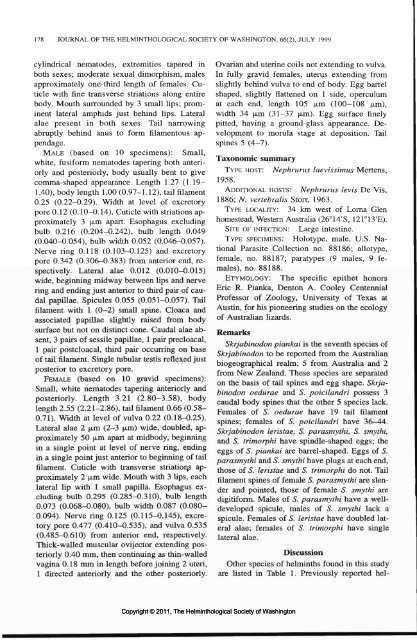The Helminthological Society of Washington - Peru State College
The Helminthological Society of Washington - Peru State College
The Helminthological Society of Washington - Peru State College
Create successful ePaper yourself
Turn your PDF publications into a flip-book with our unique Google optimized e-Paper software.
178 JOURNAL OF THE HELMINTHOLOGICAL SOCIETY OF WASHINGTON, 66(2), JULY 1999<br />
cylindrical nematodes, extremities tapered in<br />
both sexes; moderate sexual dimorphism, males<br />
approximately one-third length <strong>of</strong> females. Cuticle<br />
with fine transverse striations along entire<br />
body. Mouth surrounded by 3 small lips; prominent<br />
lateral amphids just behind lips. Lateral<br />
alae present in both sexes. Tail narrowing<br />
abruptly behind anus to form filamentous appendage.<br />
MALE (based on 10 specimens): Small,<br />
white, fusiform nematodes tapering both anteriorly<br />
and posteriorly, body usually bent to give<br />
comma-shaped appearance. Length 1.27 (1.19-<br />
1.40), body length 1.00 (0.97-1.12), tail filament<br />
0.25 (0.22-0.29). Width at level <strong>of</strong> excretory<br />
pore 0.12 (0.10-0.14). Cuticle with striations approximately<br />
3 |xm apart. Esophagus excluding<br />
bulb 0.216 (0.204-0.242), bulb length 0.049<br />
(0.040-0.054), bulb width 0.052 (0.046-0.057).<br />
Nerve ring 0.118 (0.103-0.125) and excretory<br />
pore 0.342 (0.306-0.383) from anterior end, respectively.<br />
Lateral alae 0.012 (0.010-0.015)<br />
wide, beginning midway between lips and nerve<br />
ring and ending just anterior to third pair <strong>of</strong> caudal<br />
papillae. Spicules 0.055 (0.051-0.057). Tail<br />
filament with 1 (0-2) small spine. Cloaca and<br />
associated papillae slightly raised from body<br />
surface but not on distinct cone. Caudal alae absent,<br />
3 pairs <strong>of</strong> sessile papillae, 1 pair precloacal,<br />
1 pair postcloacal, third pair occurring on base<br />
<strong>of</strong> tail filament. Single tubular testis reflexed just<br />
posterior to excretory pore.<br />
FEMALE (based on 10 gravid specimens):<br />
Small, white nematodes tapering anteriorly and<br />
posteriorly. Length 3.21 (2.80-3.58), body<br />
length 2.55 (2.21-2.86), tail filament 0.66 (0.58-<br />
0.71). Width at level <strong>of</strong> vulva 0.22 (0.18-0.25).<br />
Lateral alae 2 |xm (2-3 |o,m) wide, doubled, approximately<br />
50 (Jim apart at midbody, beginning<br />
in a single point at level <strong>of</strong> nerve ring, ending<br />
in a single point just anterior to beginning <strong>of</strong> tail<br />
filament. Cuticle with transverse striations approximately<br />
2 u,m wide. Mouth with 3 lips, each<br />
lateral lip with 1 small papilla. Esophagus excluding<br />
bulb 0.295 (0.285-0.310), bulb length<br />
0.073 (0.068-0.080), bulb width 0.087 (0.080-<br />
0.094). Nerve ring 0.125 (0.115-0.145), excretory<br />
pore 0.477 (0.410-0.535), and vulva 0.535<br />
(0.485-0.610) from anterior end, respectively.<br />
Thick-walled muscular ovijector extending posteriorly<br />
0.40 mm, then continuing as thin-walled<br />
vagina 0.18 mm in length before joining 2 uteri,<br />
1 directed anteriorly and the other posteriorly.<br />
Ovarian and uterine coils not extending to vulva.<br />
In fully gravid females, uterus extending from<br />
slightly behind vulva to end <strong>of</strong> body. Egg barrel<br />
shaped, slightly flattened on 1 side, operculum<br />
at each end, length 105 fjim (100-108 |xm),<br />
width 34 (Jim (31-37 (xm). Egg surface finely<br />
pitted, having a ground-glass appearance. Development<br />
to morula stage at deposition. Tail<br />
spines 5 (4-7).<br />
Taxonomic summary<br />
TYPE HOST: Nephrurus laevissimus Mertens,<br />
1958.<br />
ADDITIONAL HOSTS: Nephrurus levis De Vis,<br />
1886; N. vertebralis Storr, 1963.<br />
TYPE LOCALITY: 34 km west <strong>of</strong> Lorna Glen<br />
homestead, Western Australia (26°14'S, 121°13'E).<br />
SITE OF INFECTION: Large intestine.<br />
TYPE SPECIMENS: Holotype, male, U.S. National<br />
Parasite Collection no. 88186; allotype,<br />
female, no. 88187; paratypes (9 males, 9 females),<br />
no. 88188.<br />
ETYMOLOGY: <strong>The</strong> specific epithet honors<br />
Eric R. Pianka, Denton A. Cooley Centennial<br />
Pr<strong>of</strong>essor <strong>of</strong> Zoology, University <strong>of</strong> Texas at<br />
Austin, for his pioneering studies on the ecology<br />
<strong>of</strong> Australian lizards.<br />
Remarks<br />
Skrjabinodon piankai is the seventh species <strong>of</strong><br />
Skrjabinodon to be reported from the Australian<br />
biogeographical realm; 5 from Australia and 2<br />
from New Zealand. <strong>The</strong>se species are separated<br />
on the basis <strong>of</strong> tail spines and egg shape. Skrjabinodon<br />
oedurae and S. poicilandri possess 3<br />
caudal body spines that the other 5 species lack.<br />
Females <strong>of</strong> S. oedurae have 19 tail filament<br />
spines; females <strong>of</strong> S. poicilandri have 36-44.<br />
Skrjabinodon leristae, S. parasmythi, S. smythi,<br />
and 5. trimorphi have spindle-shaped eggs; the<br />
eggs <strong>of</strong> S. piankai are barrel-shaped. Eggs <strong>of</strong> S.<br />
parasmythi and S. smythi have plugs at each end,<br />
those <strong>of</strong> 5. leristae and 5. trimorphi do not. Tail<br />
filament spines <strong>of</strong> female 5. parasmythi are slender<br />
and pointed, those <strong>of</strong> female S. smythi are<br />
digitiform. Males <strong>of</strong> 5. parasmythi have a welldeveloped<br />
spicule, males <strong>of</strong> 5. smythi lack a<br />
spicule. Females <strong>of</strong> S. leristae have doubled lateral<br />
alae; females <strong>of</strong> S. trimorphi have single<br />
lateral alae.<br />
Discussion<br />
Other species <strong>of</strong> helminths found in this study<br />
are listed in Table 1. Previously reported hel-<br />
Copyright © 2011, <strong>The</strong> <strong>Helminthological</strong> <strong>Society</strong> <strong>of</strong> <strong>Washington</strong>
















